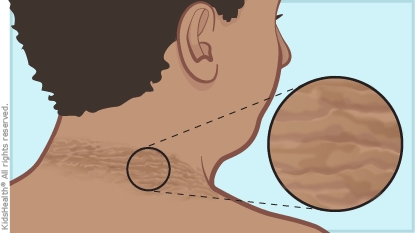- Home
- Parents Home
- Allergy Center
- Asthma Center
- Cancer Center
- Diabetes Center
- A to Z Dictionary
- Emotions & Behavior
- First Aid & Safety
- Food Allergy Center
- General Health
- Growth & Development
- Flu Center
- Heart Health
- Homework Help Center
- Infections
- Diseases & Conditions
- Nutrition & Fitness Center
- Play & Learn Center
- School & Family Life
- Pregnancy Center
- Newborn Center
- Q&A
- Recipes
- Sports Medicine Center
- Doctors & Hospitals
- Videos
- Para Padres
- Home
- Kids Home
- Asthma Center
- Cancer Center
- Movies & More
- Diabetes Center
- Getting Help
- Feelings
- Puberty & Growing Up
- Health Problems of Grown-Ups
- Health Problems
- Homework Center
- How the Body Works
- Illnesses & Injuries
- Nutrition & Fitness Center
- Recipes & Cooking
- Staying Healthy
- Stay Safe Center
- Relax & Unwind Center
- Q&A
- Heart Center
- Videos
- Staying Safe
- Kids' Medical Dictionary
- Para Niños
- Home
- Teens Home
- Asthma Center
- Be Your Best Self Center
- Cancer Center
- Diabetes Center
- Diseases & Conditions
- Drugs & Alcohol
- Expert Answers (Q&A)
- Flu Center
- Homework Help Center
- Infections
- Managing Your Medical Care
- Managing Your Weight
- Nutrition & Fitness Center
- Recipes
- Safety & First Aid
- School & Work
- Sexual Health
- Sports Center
- Stress & Coping Center
- Videos
- Your Body
- Your Mind
- Para Adolescentes
Acanthosis Nigricans
What Is Acanthosis Nigricans?
Acanthosis nigricans (ah-kan-THO-sis NY-gruh-kans) is a skin condition. It causes thicker and darker patches or streaks, usually in skin creases and folds, such as the sides and back of the neck, armpits, elbow pits, and groin. But it can show up anywhere on the body. It may look velvety or warty, or have a dirty appearance.
What Causes Acanthosis Nigricans?
Acanthosis nigricans most often is caused by high blood insulin levels, a condition called insulin resistance. Insulin resistance is seen in kids who are overweight or obese and makes them more likely to develop type 2 diabetes. It is also linked with other endocrine conditions, such as polycystic ovary syndrome (PCOS).
In some cases, acanthosis nigricans can be hereditary (passed on to a child by their parents) or part of a genetic syndrome. It can be caused by medicines, such as oral contraceptives or steroids. Acanthosis nigricans can be a warning sign of some types of cancers, but this is very rare in children.
What Are the Signs & Symptoms of Acanthosis Nigricans?
Acanthosis nigricans appears gradually with dark, velvety patches of skin in body creases and folds, usually in the neck, armpits, or groin. It can be found on other parts of the body, including the face, chest, elbows, knees, and knuckles. Children may have mild itching, but this is uncommon.

How Is Acanthosis Nigricans Diagnosed?
If you think your child has acanthosis nigricans, see your doctor. Doctors can diagnose acanthosis nigricans by looking at the affected skin.
The doctor may order blood tests to look for diabetes or other conditions associated with it.
How Is Acanthosis Nigricans Treated?
Treating the underlying cause of acanthosis nigricans can make the dark patches of skin fade or disappear. This can mean stopping any medicine that’s causing the problem or treating diabetes and other health conditions.
If your child is overweight, losing weight will help acanthosis nigricans fade. Talk to your doctor before putting your child on a diet.
To help kids feel better about how their skin looks, doctors may prescribe creams or lotions that can help lighten the skin. But acanthosis nigricans usually doesn’t need any treatment.
What Else Should I Know?
Skin areas with acanthosis nigricans can look dirty, but they’re not. Scrubbing the skin does not help and can irritate it. Gently clean the skin and don’t use bleaches, skin scrubs, or over-the-counter exfoliating treatments.
Eating a healthy diet and getting regular physical activity can help lower insulin levels and improve skin appearance. Try these tips:
- Choose whole grains and plenty of fruits and vegetables.
- Offer water or low-fat milk instead of soda, juice, or other sugary drinks.
- Limit highly processed foods, fatty foods, and sugary treats.
- Encourage your child to be physically active every day.

© 1995- The Nemours Foundation. KidsHealth® is a registered trademark of The Nemours Foundation. All rights reserved.
Images sourced by The Nemours Foundation and Getty Images.
